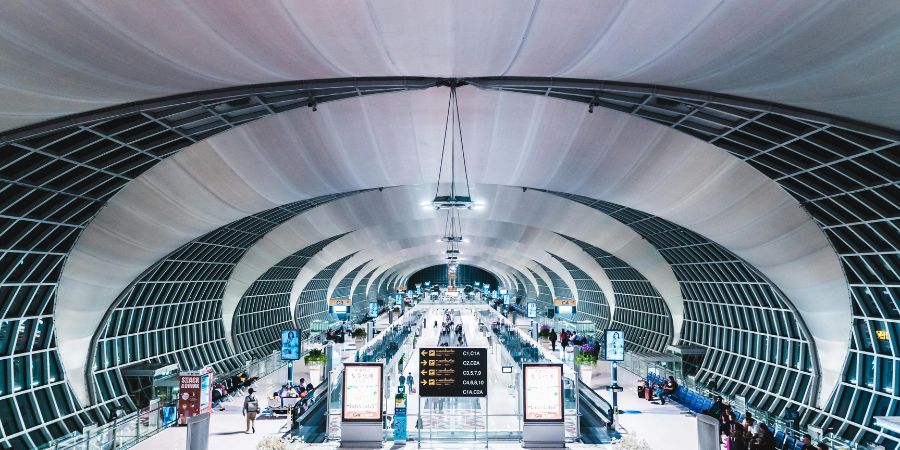In recent years, air travel in the United States has become record-setting. According to the Federal Aviation Administration, more than 45,000 flights take off each day, moving over 2.9 million passengers. With that much volume happening, the size and capacity of the airports become extremely important to the health of the system. Bigger airports in the US serve tens of millions of passengers annually and often operate as small cities complete with a transit system, hotel, and business center.
Airports are not just locations of departures or arrivals. They drive local economies, link global markets, and often dictate how a traveler experiences long-distance journeys. Let’s take a look at the top 10 biggest airports in the US based on some combination of size, passenger volume, and importance.
1. Hartsfield-Jackson Atlanta International Airport
Hartsfield-Jackson in Atlanta is the busiest airport in the U.S. and has been for many years. It serves more than 100 million passengers a year and is the leading hub for Delta Air Lines.
The layout is the most economical and efficient of all major US airports by size with concourses connected via an underground train. Atlanta is situated in a location that facilitates travel to most of the U.S. in less than 2 hours of flying time; thus, Atlanta is also a popular first stop for domestic and international connections.
2. Los Angeles International Airport
Los Angeles International Airport, often referenced simply as LAX, is one of the largest airports in the US and a gateway to the Pacific Rim. It serves approximately 88 million passengers a year and is the first point of international connection to Asia, Australia, and Latin America.
With its uniquely designed horseshoe configuration of nine terminals, LAX can be confusing for first-time travelers, although there are many international connections to choose from. LAX is also often mentioned in US airport rankings due to its passenger traffic.
3. Chicago O’Hare International Airport
For some time, Chicago O’Hare has been busy – considering passengers and aircraft movements. It is in the Midwest and provides coast-to-coast links while being a hub for United Airlines and American Airlines. O’Hare handles about 83 million passengers a year.
O’Hare is also famous for its runways, which reduce the risk of delays, despite the amount of air traffic. For many who fly, O’Hare is among the biggest airports in the US and the gateway to international locations in Europe and Asia, while maintaining a robust domestic boarding population.
4. Dallas Fort Worth International Airport
Dallas Fort Worth International Airport is an expansive area of land (almost the size of Manhattan). DFW handles around 75 million passengers annually. DFW is the primary hub for American Airlines, one of the world’s largest carriers, and is connected by a Skylink train between all five terminals for seamless travel from a domestic carrier to international carrier. Dallas Fort Worth is also an important cargo airport in order to support Texas’ significant footprint in trade and logistics, and it is one of the largest travel hubs in the US.
5. Denver International Airport
Denver International Airport is distinguished by its architecture with a terminal whose roof resembles snow-covered mountain summits – a tribute to the Mountain West region and the nearby Rocky Mountains. The airport is the largest airport in the US in area, encompassing more than 33,000 acres of land.
Its annual passenger volume continues to grow, currently facilitating more than 70 million passengers per year. Denver is a hub for United Airlines and Southwest Airlines and is a significant connecting point for travelers to the Rocky Mountain region. Its long runways also make Denver International an important airport for long-haul air travel and a regular mention in US airport rankings.
6. John F. Kennedy International Airport
John F. Kennedy International Airport is one of the most well-known airports around the globe. JFK accommodates about 62 million passengers each year and is one of the biggest airports for travel in the US.
John F. Kennedy has six passenger terminals, is a base of operations for major air carriers Delta and American Airlines, and is a major cargo hub of incoming air freight from Asia and Europe. For millions of passengers visiting the United States, JFK is their first impression of America and part of the American travel identity.
7. San Francisco International Airport
San Francisco International Airport, abbreviated as SFO, is a primary airport for travelers to and from Asia and Europe, with approximately 58 million passengers per year. It has a modern design and traveler amenities, including a museum of art exhibits in its terminals.
SFO is also a sustainability leader with programs to reduce its carbon footprint and increase energy efficiency. Furthermore, the airport is conveniently located adjacent to Silicon Valley and becomes a stopover for many business travelers in the technology sector. SFO is consistently included in the top 10 biggest airports in the US lists.
8. Seattle-Tacoma International Airport
Seattle-Tacoma International Airport, or Sea-Tac, has experienced a high level of growth over the last few years, handling approximately 52 million passengers each year. Sea-Tac serves as the primary airport for Alaska Airlines, as well as an important gateway supporting access to Asia.
The airport provides vital connections between the Pacific Northwest and the rest of the country and world. As a result of contributing to its facilities and several years of increased passenger traffic, Sea-Tac has become one of the largest travel hubs in the US and is often highlighted in US airport rankings.
9. Orlando International Airport
Orlando International Airport is a tourism-centered airport, managed by the Greater Orlando Aviation Authority, serving about 50 million passengers annually. It is the busiest airport in the State of Florida, with huge volumes of travelers from all over the world arriving to visit several international attractions like Walt Disney World and Universal Studios, among many other travelers arriving for leisure purposes every year.
Orlando International Airport has four runways, and has been built with heavy leisure travel in mind. This airport is fundamental to the tourism-based economy of Florida, as it continues to receive millions of vacationers annually. It is one of the biggest airports in the US by passenger traffic.
10. Miami International Airport
Miami International Airport is the primary hub for North American, South American, and Caribbean travel. It receives roughly 45 million passengers per year, serves as a primary hub for American Airlines, is a leader in international cargo (especially perishables like flowers and seafood), and Miami has location and cultural significance as a business bridge and strong contributor to many movements of commerce around the United States and Latin America along with its potential to serve as one of the major US airports by size.
Why Bigger Airports in the US Matter
The biggest airports in the US serve purposes beyond being transportation hubs. They create jobs, they attract investment from around the globe, and they contribute billions of dollars to the local economy. They serve a purpose beyond connecting communities across the United States and the world.
Airports like Atlanta and Dallas Fort Worth show that location and scale can make an airport into a gateway of global connectivity. Other airports, like San Francisco and Seattle, highlight regional strengths and partnerships in global technology and trade. For travelers, these largest airports in the US can access a large number of destinations, usually with fewer, quicker connections.
Final Takeaway
Big airports in the US carry the expectations of global travel around the world with them. Each airport on this top 10 biggest airports in the US list has its unique contribution of volume of passenger, geographical advantage, or number of international connections.
Together they provide the backbone of the aviation system, facilitating the travel of people, goods, and cultures across continents. If you are planning future travel, knowledge of these largest travel hubs in the US can aid in making better decisions about routes, layovers, and/or connecting flights. Life for bigger airports in the US specifically will continue to broaden, grow, modernize and change, but the role for the purposes of global movement will always be there.



